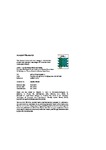Seasonal and depth-driven changes in rhodolith bed structure and associated macroalgae off Arvoredo island (southeastern Brazil)
| dc.contributor.author | Pascelli, C | |
| dc.contributor.author | Riul, P | |
| dc.contributor.author | Riosmena-Rodríguez, R | |
| dc.contributor.author | Scherner, F | |
| dc.contributor.author | Nunes, M | |
| dc.contributor.author | Hall-Spencer, JM | |
| dc.contributor.author | Oliveira, ECD | |
| dc.contributor.author | Horta, P | |
| dc.date.accessioned | 2014-02-13T11:44:20Z | |
| dc.date.available | 2014-02-13T11:44:20Z | |
| dc.date.issued | 2013-11 | |
| dc.identifier.issn | 0304-3770 | |
| dc.identifier.issn | 1879-1522 | |
| dc.identifier.uri | http://hdl.handle.net/10026.1/2887 | |
| dc.description.abstract |
Rhodoliths are formed by coralline red algae and can form heterogeneous substrata with high biodiversity. Here we describe a rhodolith bed at the southern limit of the known distribution of this habitat in the western Atlantic. We characterized rhodolith and macroalgal assemblages at 5, 10 and 15. m depth during summer and winter. Lithothamnion crispatum was dominant amongst the six rhodolith-forming species present. Most rhodoliths were spheroidal in shape indicating high mobility due to water movement. Rhodolith density decreased with increasing depth and during winter. Turf-forming seaweeds accounted for 60% of the biomass growing on rhodoliths. Macroalgae increased abundance and richness in the summer, but was similar between 5 and 15. m depth. They were less abundant and diverse than that recorded in rhodolith beds further north in Brazil. Both, season and depth, affected the structure of the macroalgae assemblages. We conclude that Lithothamniom is the most representative genus of Brazilian rhodolith beds. Summer is responsible for increasing the diversity and richness of macroalgae, as well as increasing rhodolith density. © 2013 Elsevier B.V. | |
| dc.format.extent | 62-65 | |
| dc.language | en | |
| dc.language.iso | en | |
| dc.publisher | Elsevier BV | |
| dc.subject | Coralline algae | |
| dc.subject | Macroalgae | |
| dc.subject | Marine biodiversity | |
| dc.subject | Marine protected area | |
| dc.subject | Lithothamnion crispatum | |
| dc.title | Seasonal and depth-driven changes in rhodolith bed structure and associated macroalgae off Arvoredo island (southeastern Brazil) | |
| dc.type | journal-article | |
| dc.type | Article | |
| plymouth.author-url | https://www.webofscience.com/api/gateway?GWVersion=2&SrcApp=PARTNER_APP&SrcAuth=LinksAMR&KeyUT=WOS:000328099800010&DestLinkType=FullRecord&DestApp=ALL_WOS&UsrCustomerID=11bb513d99f797142bcfeffcc58ea008 | |
| plymouth.volume | 111 | |
| plymouth.publication-status | Published | |
| plymouth.journal | Aquatic Botany | |
| dc.identifier.doi | 10.1016/j.aquabot.2013.05.009 | |
| plymouth.organisational-group | /Plymouth | |
| plymouth.organisational-group | /Plymouth/Faculty of Science and Engineering | |
| plymouth.organisational-group | /Plymouth/Faculty of Science and Engineering/School of Biological and Marine Sciences | |
| plymouth.organisational-group | /Plymouth/PRIMaRE Publications | |
| plymouth.organisational-group | /Plymouth/REF 2021 Researchers by UoA | |
| plymouth.organisational-group | /Plymouth/REF 2021 Researchers by UoA/UoA07 Earth Systems and Environmental Sciences | |
| plymouth.organisational-group | /Plymouth/Research Groups | |
| plymouth.organisational-group | /Plymouth/Research Groups/Marine Institute | |
| plymouth.organisational-group | /Plymouth/Users by role | |
| plymouth.organisational-group | /Plymouth/Users by role/Academics | |
| dc.identifier.eissn | 1879-1522 | |
| dc.rights.embargoperiod | Not known | |
| rioxxterms.versionofrecord | 10.1016/j.aquabot.2013.05.009 | |
| rioxxterms.licenseref.uri | http://www.rioxx.net/licenses/all-rights-reserved | |
| rioxxterms.type | Journal Article/Review |


